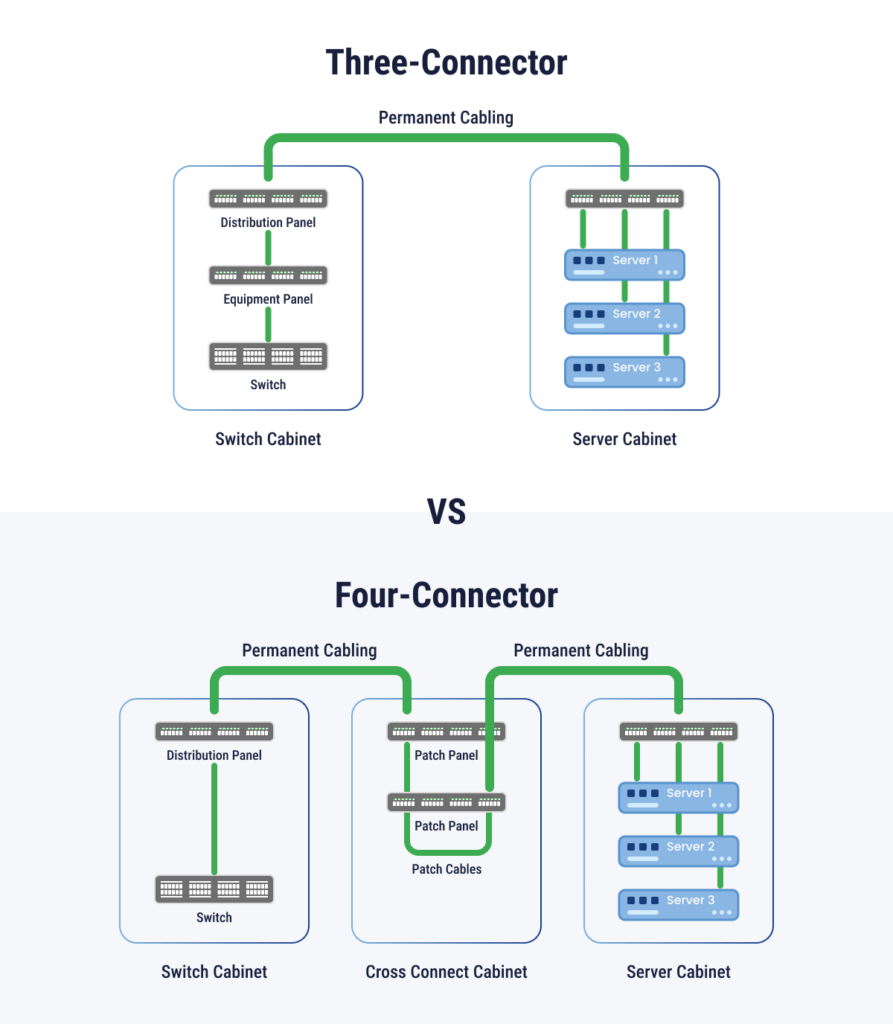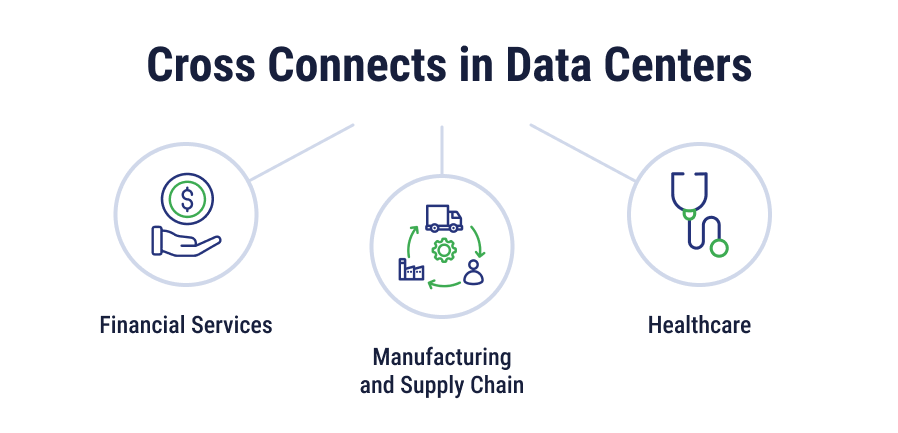December 7, 2023 | Matt Pacheco
Cross Connects in Data Centers: What is it & Understanding the Role

The days of waiting for data are long over. Seamless network connectivity has gone from a lofty goal to a practical requirement. Cross connects in data centers can facilitate vast data exchange between diverse networks that prioritize performance, security, and efficiency, playing an important role in many industries where immediate and secure access to data is critical. We’ll cover the basics on what a cross connect is, types of cross connects, key benefits, and challenges of implementation.
What is a Cross Connect?
A cross connect in a data center provides physical connections between equipment and various network providers. Think of it as a centralized hub that offers customers interconnected networks from several network service providers. Cross connects in data center environments make private and direct data exchange possible.
Cross Connect vs. Interconnect
While interconnect and cross connect connections serve similar purposes, they are structured differently. A cross connect denotes a physical connection between two networks, normally with a cable. Through the cable, networks can exchange direct traffic. Two private networks can be connected using cross connects. This type of connection can also be used to connect a private network to a public network like the internet. Interconnect, on the other hand, virtually connects networks using virtual circuits or software-defined networking (SDN). Generally, interconnects are used to connect public networks or to connect a private network with a cloud network.
Types of Cross Connects
Two main types of cross connectors are three-connectors and four-connectors. Many different types of cables can also facilitate cross connects.

Three-Connector
A three-connector cross connect uses two equipment panels and one distribution panel, so three panels in total. Equipment panels connect to network devices and distribution panels interconnect the equipment panels. These types of cross connects are common in small to medium-sized data centers.
Four-Connector
Four-connector cross connects use four panels instead of three. This includes two equipment panels, one cross connect cabinet, and one distribution panel. The cross connect cabinet serves as a mirror. It has an additional patch panel that mirrors the distribution panel on one side and the equipment panel on the other. These cross connects are generally used in larger data centers and are more flexible and scalable.
Equipment Used in Cross Connects
Different cables are appropriate for different types of cross connects. Optical fiber cables, like SMF (Single-Mode Fiber) and MMF (Multi-Mode Fiber), work well for long-distance, high-speed cross connects. Twisted-pair cables, such as CAT5 and CAT6 Ethernet, are used more for short-distance cross connects. Applications that have high bandwidth requirements may be best suited with COAX. Copper is a versatile cable that can be used in many different contexts. Data transmission at lower speeds and voice communication can be facilitated using POTS (Plain Old Telephone Service).
Why Are Cross Connects Important in Data Centers?
Organizations that handle large amounts of data, have stringent needs for security and reliability, or those that need real-time data communication can benefit greatly from cross connects. Cross connects within the data center can help businesses accomplish secure network connectivity that keeps performance high and latency low, along with other benefits.
Key Benefits of Cross Connects in Data Centers
Reduced Latency
Because cross connects offer a physical link between endpoints, they can reduce latency – the time taken for packets to travel from one device to another. This direct connection bypasses the congestion common on the public internet. Low or no latency is necessary for applications like online gaming, video conferences, and financial trading that require data transfer in real-time.
Improved Security
Cross connects reduce the risks associated with the public internet, including data interception and unauthorized access. Data centers and colocation facilities that host cross connects serve as more controlled environments that can improve security for businesses.
Reliability
Bypassing the step to route traffic through the public internet improves reliability via cross connects. If businesses need more consistent network performance for critical operations, customer service, or other urgent needs, cross connects can provide that reliability.
Flexibility and Scalability
Customization is made easier with cross connects, which can be scaled up or down in response to network traffic needs or subsequent service requirements.
Direct Access
Instead of routing through third-party networks, cross connects create direct connections to internet service providers, cloud providers, and other network providers.
Challenges of Implementing Cross Connects in Data Centers
While cross connects can bring significant advantages to customers in data centers, they’re not without their challenges.
Planning and Upfront Costs
Implementing cross connects successfully requires extensive planning and financial investment. Network administrators, service providers, and data center personnel need to be aligned to coordinate and set up cross connects. Long-distance connections and specialized equipment can mean high initial costs for hardware and installation, as well as ongoing maintenance fees.
Security
Even though cross connects can be more secure than public internet networks, certain measures need to be put in place to ensure security. Data centers may incorporate firewalls, access control, and intrusion prevention systems to keep data safe.
Integration
A data center with existing infrastructure needs to be deliberate about how it adds new cross connects to incorporate them in a way that doesn’t disrupt other services. Integration is also important in terms of coordination and vendor management. Multiple service providers and vendors need to be involved in cross connect implementation and management, which can be a lot to coordinate.
Compliance
In conjunction with security concerns, data center environments need to implement cross connects in a way that is compliance with the necessary industry regulations and data privacy standards. This becomes more complicated when more businesses and industries are part of the connecting networks.
Use Cases for Cross Connects in Data Centers
Cloud providers use cross connects to connect networks and internet service providers (ISPs) within the same building, often for the same company. Certain industries may find cross connects more necessary than others, especially those that rely on real-time data and enhanced security, such as financial services, manufacturing, and healthcare.

Financial Services
Real-time market data can mean the difference between a desired transaction and one that misses the market. Financial services organizations can greatly improve their performance by connecting directly with financial market data sources that keep up with the pace of investments.
Manufacturing and Supply Chain
Improving latency and connectivity in manufacturing can directly lead to a more efficient supply chain. This could look like a manufacturing business using cross connects in a data center to connect with certain companies that are explicitly part of the supply chain or ones that improve operation within the supply chain – maintenance companies, ERP companies, and manufacturing partners, to name a few.
Healthcare
Much of the data that’s part of the healthcare ecosystem is highly sensitive. Not only can the patient data landscape become more secure when health systems enable cross connects between labs and imaging entities, for example, but it can also become more efficient. When health data is critical and every moment counts, improved reliability and connectivity can really add up for improved patient outcomes.
Strengthen Your Network Infrastructure with IT Network Services
Businesses that want to remain competitive in the digital marketplace need to focus on reliable, low-latency connectivity. Whether you’re looking to accommodate Internet of Things (IoT) devices, consistently deliver real-time data, or provide a safe, reliable portal for customer data, unreliable network IT services are not going to cut it.
Learn more about TierPoint’s low-latency, reliable network services and how they can help you achieve your digital transformation goals.

FAQs
While cross connects have physical connections between networks, normally a cable, peering connects two networks over a virtual circuit.
By using cross connects in a data center, businesses can create private, direct connections between service providers and network devices.
The direct connection offered by cross connects bypasses the public internet. This connection can reduce latency and congestion that can come with shared public networks.
